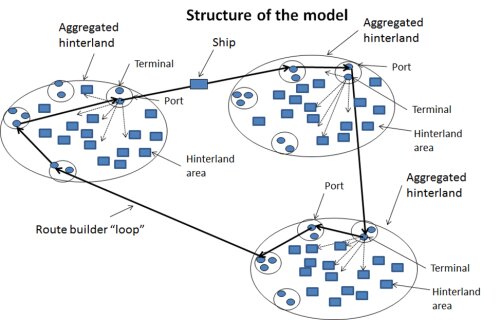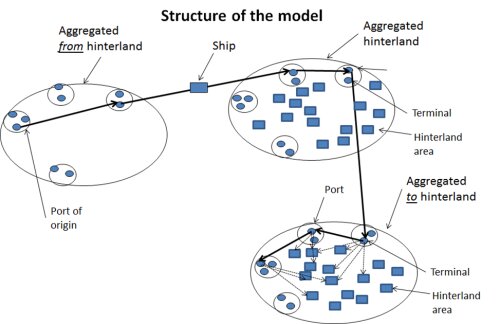TPR Chain Cost was developed as a model that allows calculating the generalised chain cost from a selected point of origin, via a predefined container loop to destination point. The model was coded in C# and uses Microsoft Excel (data) and JMP11 (maps) as output formats. In order to calculate the chain cost, first a container loop has to be defined. A loop is defined as a circle route of a ship from one port to the next (it has no beginning nor an end). This loop will determine the maritime part of the chain. In figure 1, the general overview of the developed model is given.
The container loop encompasses the maritime leg of the supply chain. Figure 1 provides a general overview of the original model (van Hassel et al., 2016).
In the model, different aggregated hinterlands are connected via a route along ports (bold lines in Figure 1). The aggregated hinterlands are defined as a summation of different smaller geographical areas, which in Europe correspond to NUTS-2 areas. Each aggregated hinterland is served by at least one and usually by several ports. Each port is built up of a set of terminals, all of which have their own set of characteristics. From each port terminal, the hinterland connections via road, rail and inland waterways (if applicable) to all the disaggregated hinterland regions are incorporated into the model.
Figure 1: structure of the model

From each terminal in a port, the hinterland distances via road, rail and inland waterways (if available) are incorporated in the model. Using the hinterland distances, it is possible to calculate the hinterland cost per mode from a terminal to a hinterland destination.
A chain is defined as a route from a hinterland area in a specific aggregated hinterland to another hinterland area in another aggregated hinterland. A chain therefore has a beginning and an end. In order to calculate the chain cost from a point a origin to a destination point, the model must not only calculate the total cost of the ship, but it must also incorporate the cost of transporting a container from a hinterland area to a port on both ends of the chain, the cost of a container in the port phase (port dues, pilotage, container handling, etc.) on both chain sides, and the cost of transporting via sea the container from the port of loading to a port of unloading. In Figure 2, the overview of the model is given when a chain calculation is made.
Figure 2: overview of a chain calculation

A hinterland model is developed that will be used to calculate the hinterland transport cost from the selected container terminals in the selected ports in Europe, the US and China. The generalised costs of three different transportation options (road, rail and inland waterways) are calculated. Therefore, with this model, also purely land-based flows can handled, for instance using rail.
An important element of the generalised cost is the transport time. The transport time for the entire transport chain is therefore incorperated in the model. This means that the transport time from a hinterland region (including a dwell time at an inland terminal for rail or IWT) to a port, the dwell time of container at a deepsea port, the maritime transport and the reverse port and land transport times at the destination hinterland are taken into account. This means that a change in a loop structure will impact on the generalised cost of the total logistics chain (including the transport time).
Applications made to date:
Port Cooperation and Bundling: A Way to Reduce the External Costs of Hinterland Transport
One Belt One Road: user opportunities through chain cost calculations
Impact of the new Panama Canal on the competitiveness of the Hamburg - Le Havre range ports
Impact of scale increase of container ships on the generalised chain cost
North-South container port competition in Europe : the effect of changing environmental policy